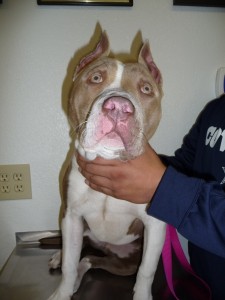Here at Powell Veterinary Service, new owners of purebred pups often ask about the process of ear cropping and how it will effect and benefit them. During the cropping procedure, ears are trimmed to stand erect instead of flopping over. Cropping is common in breeds like Boxers and Doberman Pinschers, and erect ears create an intelligent and alert look many people are fond of in these breeds.
Many owners of guard dogs prefer to have their ears cropped to create an intimidating look to ward against intruders. Working and hunting breeds also have their ears cropped, historically for safety reasons. For example, hunting breeds used to have them cropped to protect from the bites of wild animals.

While ear wounds are not usually life threatening, they do bleed a lot and frequently need to be stitched, often resulting in scarring. For owners with multiple dogs, ear cropping can prevent your animals from harming each other during rough play.
Also, ears that flop hang over the ear canal can prevent air and light from getting inside. This can result in an increase in bacteria and infection, which can lead to permanent hearing loss. For pets with frequent ear infections, cropping can reduce the problem.
While many people still believe the AKC breed standards of cropping, we feel your pets ears should be allowed either way. Deciding to have your dog’s ears cropped is a personal decision and the choice is yours alone! If you do decide to get your pup’s ears cropped, please have a professional perform the procedure. We have seen many botched home procedures that result in pain and infection, something we don’t want any pet to experience.
At Powell Veterinary Service, we typically perform the ear crop procedure on puppies between the age of eight and twelve weeks. Ears can be cropped in a variety of lengths and in a rounded or bell shape.
 Performed under general anesthesia, this surgical procedure includes the measuring, trimming and suturing of the puppy’s ears. Ears are then bandaged for support. Follow up visits take place at five to seven days to ensure proper healing and again at ten to fourteen days for suture removal. Most ears will stand in a week or two, though longer ears often take longer to stand.
Performed under general anesthesia, this surgical procedure includes the measuring, trimming and suturing of the puppy’s ears. Ears are then bandaged for support. Follow up visits take place at five to seven days to ensure proper healing and again at ten to fourteen days for suture removal. Most ears will stand in a week or two, though longer ears often take longer to stand.
To view the ear cropping procedure and some of our work, click here and scroll to the bottom of the page. Contact our Kersey, Colorado office at 970-352-9164 to learn more and to schedule an appointment for your pup.



WORKING HOURS:
Monday-Friday 8:00am - 5:00pm
Saturday 8:00am - 12:00 noon